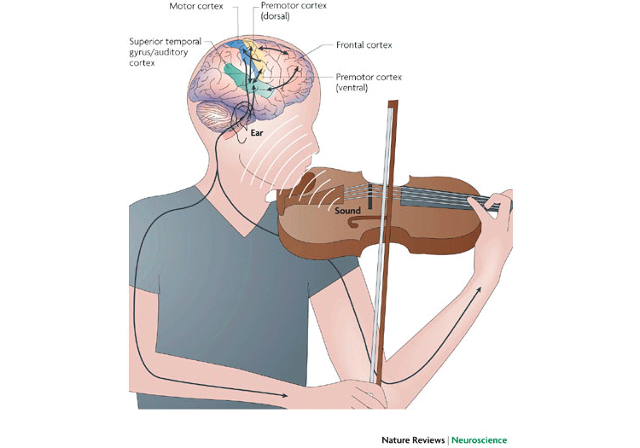| Found at www.personal.psu.edu |
“Without music, life would be a mistake” --Friedrich Nietzsche
While we all know we love music, here are some infographics and research facts (from resources listed below) to support and explain why. Note that as the infographics (especially "The Psychology of Music" by the University of Florida) may be difficult to read, I've included some of the highlights below:
- Music involves more parts of the brain than any other function that people perform. Listening and playing music involves processing tonality (see "The Psychology of Music" Infographic by the
- Listening to music has been found to improve language skills, creativity, speed healing, increase optimism, decrease pain and has been helpful in treating patients with Alzheimer's and Parkinson's Sydromes, Tourettes and Austism.
- Specific brainwave rhythms are associated with specific emotional and cognitive outcomes.
- One study showed that after hearing a short piece of music, participants were more likely to interpret a neutral expression as happy or sad, to match the tone of the music they heard. This also happened with other facial expressions, but was most notable for those that were close to neutral.
- It turns out that a moderate noise level is the sweet spot for creativity because moderate noise levels increase processing difficulty which in turn promotes abstract processing, leading to higher creativity. When we work at process things with moderate levels of difficulty, we resort to more creative approaches. However, with high noise levels, creative thinking is impaired because we’re overwhelmed struggling to process information efficiently.
- Students taking courses in music performance and music appreciation scored higher on tests than students who did not.
 |
| Found at: http://www.popsci.com/science/article/2013-02/your-brain-music-infographic |
 |
| From: http://blog.loogguitars.com/wp-content/uploads/2012/09/yourkidsbrainonmusic1.png |
In another study (with infographic):
It was found that learning to play a musical instrument is useful in more ways than we might expect. One study showed that children with three or more years of instrument training performed better in auditory discrimination abilities and fine motor skills than those who didn’t.

Additional Resources:
- Infographic on how our brains use/interpret music: http://blog.loogguitars.com/wp-content/uploads/2012/09/yourkidsbrainonmusic1.png
- Research and science of the brain and music: http://www.fastcompany.com/3022942/work-smart/the-surprising-science-behind-what-music-does-to-our-brains
As always, thanks for your visit.
Please leave your own experiences and insights on music and the brain in the comments below.
No comments:
Post a Comment